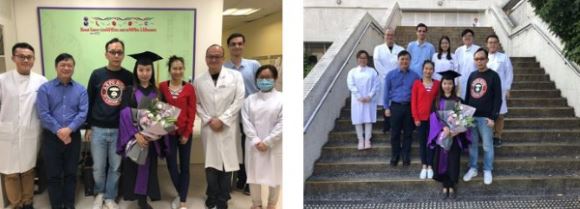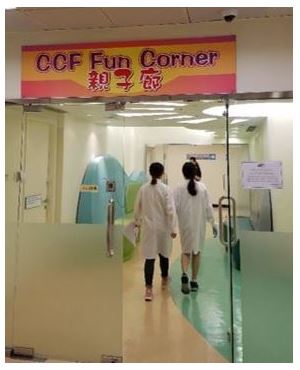Academic Research:

From multiple myeloma to plasma cell myeloma.
Margaret’s interest on myeloma took shape after her being inspired by the book on multiple myeloma edited by Bart Barlogie in 1992. Her first myeloma paper in 1997 was published in Blood, a top journal in Haematology, on frequent hypermethylation of p15 and p16 genes in multiple myeloma. The insights about epigenetics were just being unveiled in blood cancers as a new genetic chapter. Her second paper was published in 1999 in American Journal of Pathology highlighting the presence of chromosomal instability and its link to the likely myeloma clonogenic (stem) cells. Almost a decade before cancer stem cell became a pioneering research direction.
Along the course, she discovered platelet factor 4 as a tumor suppressor in myeloma on chromosome 4q13.3 by combined Comparative Genomic Hybridization, alleotyping and bisulfite sequencing supported by a RGC grant (2002) in collaboration with the Hematology Department of Chang Zheng Hospital, Shanghai and published the findings in Blood in 2007 and subsequently, validated the mechanistic involvement with STAT 3 and SOCS3 cancer signaling and its potential clinical utility in mouse humanized model with support by a grant from the Natural Science Foundation of China (NSFC/RGC Joint Research Scheme 2008). These findings were published in Haematologica in 2013.
She long observed that myeloma in Chinese are different in some aspects as compared to western patients other than having lower incidence rates. Her recent study of BRAF in myeloma (2018) has also substantiated this notion in terms of Ras signaling involvement. Rarer Ras mutations but more frequent BRAF mutation and RASSF1A methylation. These findings may have implication in the application of BRAF targeting therapy.
Human Leukocyte Antigen/Immunogenetics: post-SARS interests.
 Human Leukocyte Antigen association studies emerged as a new line of research in Margaret’s team after SARS (Severe Acute Respiratory Syndrome) outbreak in 2003 when genetic susceptibility became a hot topic that extends to various diseases, infections and cancers.
Human Leukocyte Antigen association studies emerged as a new line of research in Margaret’s team after SARS (Severe Acute Respiratory Syndrome) outbreak in 2003 when genetic susceptibility became a hot topic that extends to various diseases, infections and cancers.
Her HLA research first in SARS (picture in press) and later in other diseases brought her multiple good collaborative studies and over 10 successful publications in respective journals of the field in addition to multiple research grants from Research Fund for the Control of Infectious Diseases (2005, 2005), Kadoorie Charity Foundation (2005), Innovation & Technology Fund (2008) and the successful patenting in LAMP assay on HLA-B*15;02 in Asia 2009 supported by the University.
Equipped with the HLA testing experience and technique, Margaret’s laboratory becomes the only center in haematopathology that provides this service not for transplantation but for detection of HLA genotype at risk of drug induced Stephen Johnson’s Syndrome (SJS).
Acute Leukemia:
Acute lymphoblastic leukemia: Territory-wide flow cytometric Minimal Residual Disease (MRD) detection in Childhood ALL
 Since 2003 Margaret’s laboratory has evolved to lead the territory-wide flow cytometric MRD detection in childhood acute lymphoblastic leukemia (ALL), a research study at the beginning supported by a RGC 2007 and later on, a community service program sponsored by Children’s Cancer Foundation (CCF). An accumulated funds solicited from CCF between 2003 and 2019 exceeds 7 million HK dollars. Margaret also sought the support of CCF to improve the waiting area of finger prick service by renovation of the corridor in the old Block, which she named as Parent-Child Gallery (a place for the parents to keep loving company with the sick kid waiting and with also the meaning of kissing the kid’s painful finger to express love and care) and has become a well-known landmark for staff over a decade even though this service had been relocated after 7 years of service. A collaborative link with the European centers in I-BFM study, with Prague by involvement of mini-mini flow panel and with St Jude’s team in CCCG study has been established for the MRD studies. Recently, a new flow panel has also been developed for MRD in myeloma. A good example of cross transfer of technology once it is developed.
Since 2003 Margaret’s laboratory has evolved to lead the territory-wide flow cytometric MRD detection in childhood acute lymphoblastic leukemia (ALL), a research study at the beginning supported by a RGC 2007 and later on, a community service program sponsored by Children’s Cancer Foundation (CCF). An accumulated funds solicited from CCF between 2003 and 2019 exceeds 7 million HK dollars. Margaret also sought the support of CCF to improve the waiting area of finger prick service by renovation of the corridor in the old Block, which she named as Parent-Child Gallery (a place for the parents to keep loving company with the sick kid waiting and with also the meaning of kissing the kid’s painful finger to express love and care) and has become a well-known landmark for staff over a decade even though this service had been relocated after 7 years of service. A collaborative link with the European centers in I-BFM study, with Prague by involvement of mini-mini flow panel and with St Jude’s team in CCCG study has been established for the MRD studies. Recently, a new flow panel has also been developed for MRD in myeloma. A good example of cross transfer of technology once it is developed.
Acute Myeloid Leukemia:
Since 2005, Margaret’s research focus revisited acute myeloid leukemia (AML) after her initial study of methylation of p15 in acute leukemia published in Blood in 1999. Her team published multiple discovery and mechanistic types of studies since 2008 on transcriptional factors and leukaemogenesis. In particular, RUNX family of transcriptional factors and secreted-frizzled related protein1 (SFRP1) in Wnt signaling were investigated. In another study on helicase-like transcription factor (HLTF), a SWI/SNF chromatin remodeling factor, her team provided new mechanistic insights into genomic instability linked to HLTF deregulation and identified HLTF as a RUNX1 target in AML. Furthermore, their previous studies uncovered a microRNA-mediated control of NPM1 expression that contributes to AML disease heterogeneity.
In 2017, Margaret’s AML research team again identified a novel RARA fusion resulting from the t(3;17)(q26;q21) translocation in a variant acute promyelocytic leukaemia patient. In this fusion, RARA is fused to a gene called fibronectin type III domain containing 3B (FNDC3B), which is implicated in the differentiation of several cell types. In contrast to the aforementioned ATRA-insensitive TBLR1-RARA fusion derived from the same t(3;17) translocation, FNDC3B-RARA is unusual in that it is a potent transcriptional activator at pharmacological doses of ATRA. More interestingly, unlike other RARA partner genes, FNDC3B appears to be the only partner that was found to also participate in granulocytic differentiation. Ongoing studies are currently underway. Her team’s preliminary data indicate that FNDC3B mediates its granulocytic functions by regulating this crucial ER/granule pathway and may control terminal granulopoiesis by regulating caspase-4 and highlight the multi-faceted roles of FNDC3B in granulocytic differentiation.
In 2018, her team also discovered a new mechanism of RUNX1 upregulation via disruption of long-range transcriptional control by a novel t(5;21)(q13;q22) translocation in acute myeloid leukemia, which in 2019 has attracted a video method journal with high viewing rate to make video feature article to introduce the application of the gene editing method illustrated in the study.
All AML papers are published in high end journals [Blood 2008 2011 2017, Haematologica 2013 2013 and Molecular Cancer 2018].
Acknowledgements:
Grants : RGC (2002, 2005, 2007), RFCID (2005, 2005), Kadoorie Charity Foundation (2007), ITF (2008)
Donations: Children’s Cancer Foundation (2003, 2012-2019) and Children Thalassaemia Foundation (2009, 2011, 2016)
Research Interests:
Blood cancer studies, Tumor markers and MRD, HLA/Immunogenetics, Cytogenetics, Epigenetics, Imaging FISH, CAR-T construct, Flow cytometric applications, Transcriptional factors, Stem cell studies & Genetic editing. Others include Chinese Medicine, Sports Science (hobby) and Yoga Studies (hobby).